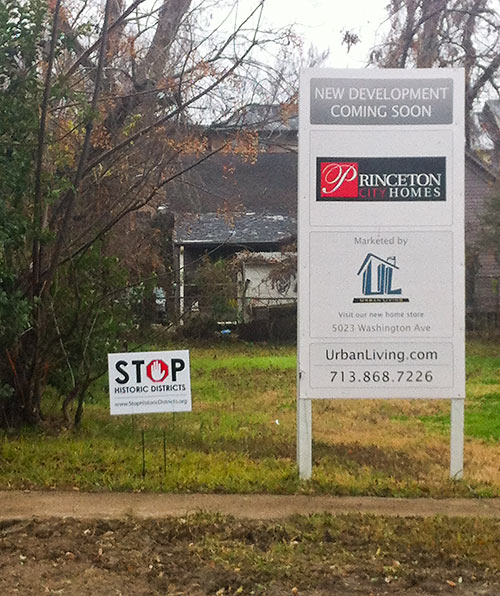
A few Swamplot readers have been sending in pics of the “Stop Historic Districts” yard signs that have been up in the First Ward for the last few weeks, the vast majority of which — at our readers’ report — have shown a remarkable affinity for lots owned by real-estate firm Urban Living or its affiliates. The signs (including the one on Crockett St. between White and Silver shown above)Â have given voice to the otherwise silent former sites of older First Ward building stock, as they jettison their former inhabitants to make room for larger, glitzier, and generally taller new construction.
***
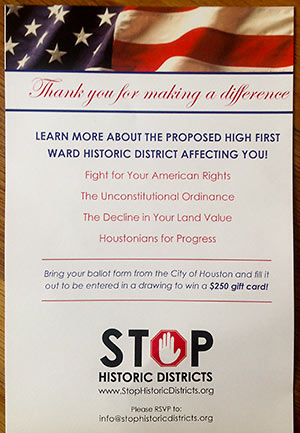 This coming Monday is the deadline for supporters of the proposed High First Ward historic district to get their ballots into the city — if they haven’t already turned them into Urban Living as raffle tickets for a $250 gift card at a “Property Rights Fair” held at the real-estate firm’s Washington Ave offices (see invite at right). For the historic district to be approved, owners representing 67 percent of the properties within the proposed boundaries would have to submit their ballots to the city indicating they support it. If that level is not reached, the city could redraw the district boundaries so that it matches up to that level of support — or give up on the effort altogether.
This coming Monday is the deadline for supporters of the proposed High First Ward historic district to get their ballots into the city — if they haven’t already turned them into Urban Living as raffle tickets for a $250 gift card at a “Property Rights Fair” held at the real-estate firm’s Washington Ave offices (see invite at right). For the historic district to be approved, owners representing 67 percent of the properties within the proposed boundaries would have to submit their ballots to the city indicating they support it. If that level is not reached, the city could redraw the district boundaries so that it matches up to that level of support — or give up on the effort altogether.
Here’s a brief photo tour of some of the lots, building sites, and future building sites silently picketing the historic-district effort in the dug-up-grass-roots campaign. On Shearn St., between White and Silver:
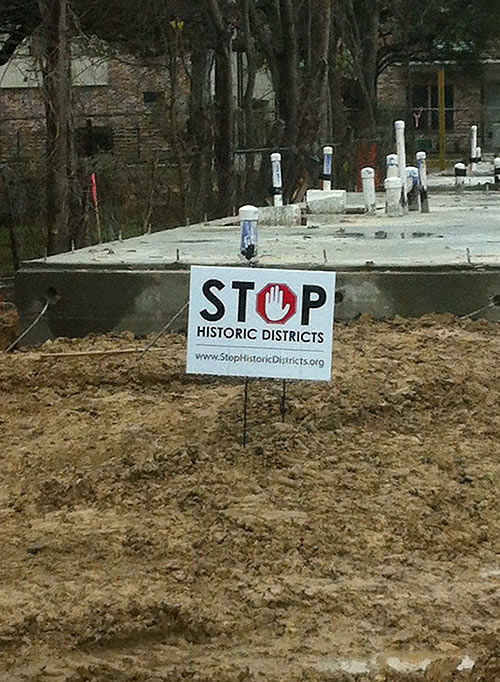
At the corner of White and Crockett:
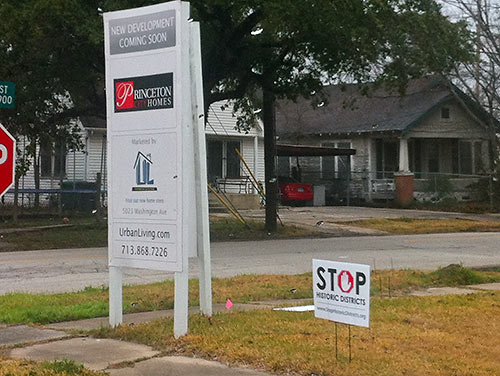
At Silver and Crockett:
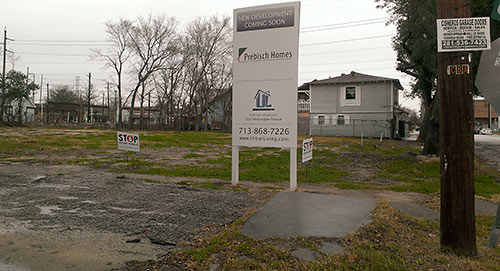
At Sabine and Shearn:
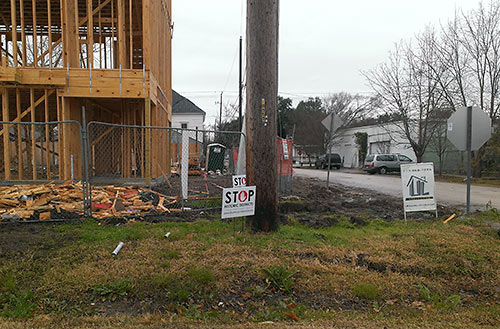
On Shearn at Silver St.:
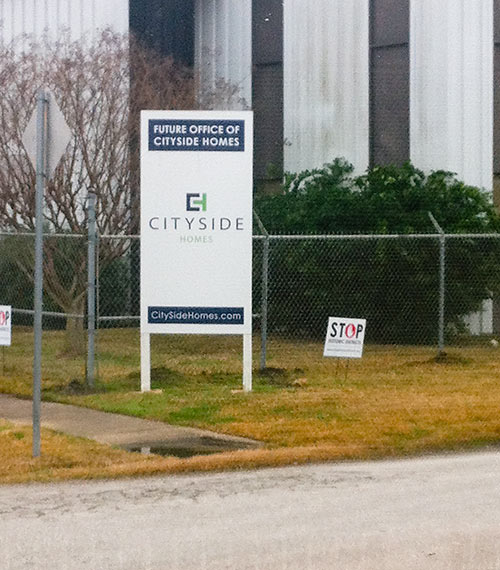
And on Crockett between White and Henderson streets:
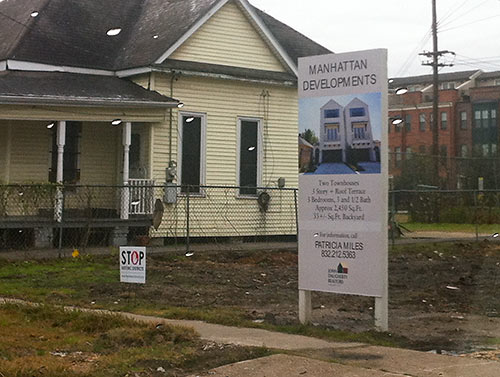
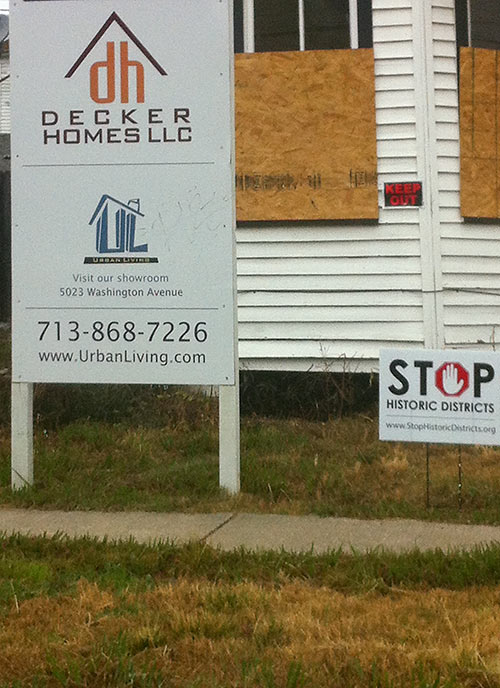
- Previously on Swamplot: Where a High First Ward Historic District Might Go
Photos: Swamplot inbox



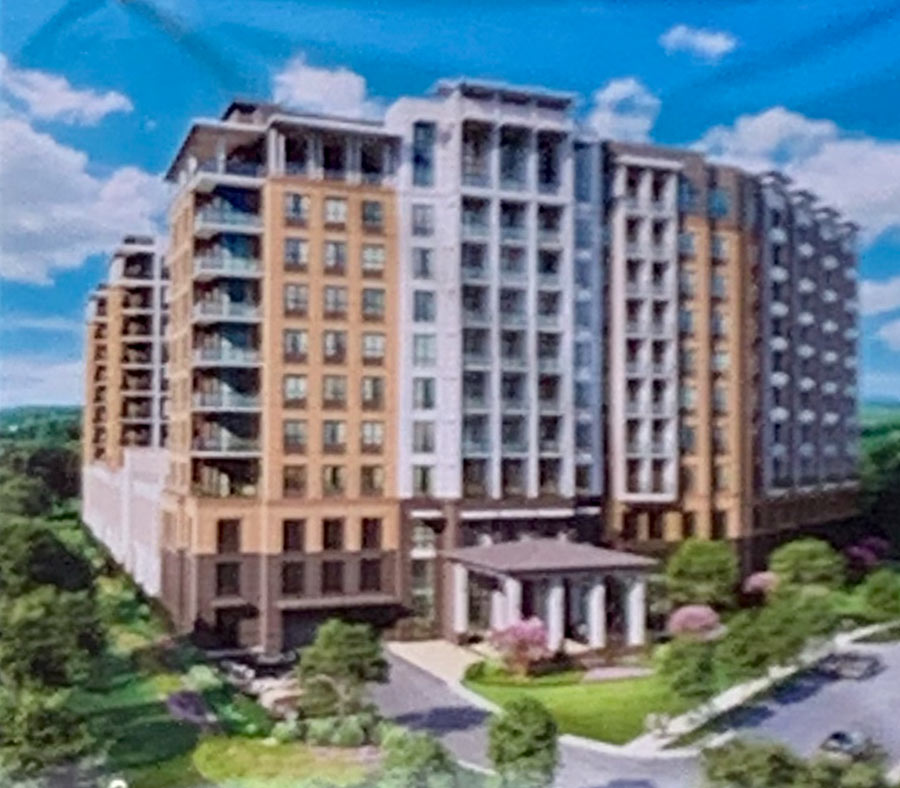
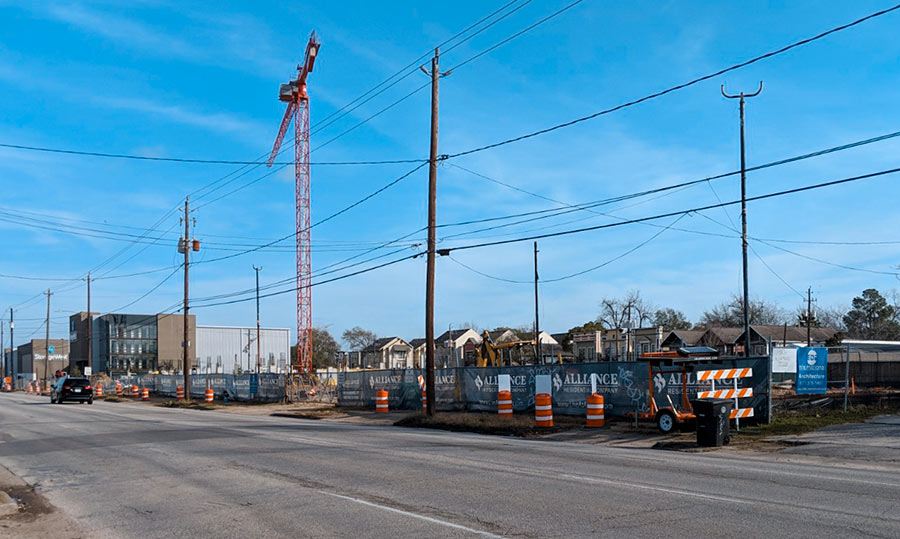
Very smart dirty tricks by Urban Living. All unreturned ballots are considered No votes. So, Urban Living spends $250 for a raffle prize and gets unsuspecting residents to give them their ballots.
The Stop Historic Districts website is terrible, looks like something thrown together by a UL receptionist in spare time. Never the less, the message is sound, historic districts rob people of their property rights and property values for very vague and arbitrary reasons and a hobby for self proclaimed aesthetics nazis.
Vinod of Urban Living has no shame when it comes to exercising his narcissism on this city.
Looks a lot like vote buying … and on the cheap.
guess you can’t blame an owner for protecting their own best interests as long. as they’re playing within the rules of the game.
you have to admit though, if all those pictures are really from the first ward I can’t find a single thing worth protecting in those pictures.
regardless, as a millennial I can’t let sentiment get the best of me and I could never morally support historic district that have been proven elsewhere to depress development and create unnecessary boundaries for new residents to move into the inner city and take advantage of whats by far our cities best infrastructure, schools and amenitites. just don’t see why becuase you can afford an inner city home that you have the right to impart your demands on the future development of the area over other nearby residents as well.
UL houses look anorexic; and they take pride in cutting down trees. Urban living to them means concrete, artificial. The only thing that makes their houses palatable is the non-UL houses around them (assuming such houses were not built by UL-type builders).
I’m all for historic Preservation….but the city really needs to allow the builders to build…If the people who own the lot cant even maintain their property then why not be able to tear it down and build anew….In a perfect world I wish we could rebuild those bungalows because they would look amazing but realistically it’ll cost too much builders will build elsewhere…and there you have it an eyesore that will be there for years…
Not sure why Urban Living is even bothering. With unreturned ballots counting as “no” votes, the historic district supporters will never get anywhere close to 67%.
Wow! Now that’s evil. A rich developer promising quick cash rewards to working people so that the developer can skirt laws that could potentially protect homeowners and neighborhoods. That way, the developer can continue to buy lots cheap and build poor quality housing to sell at a premium. The folks with StopHistoricDistricts.org don’t care about you or your property rights, First Ward – they only care about how much money they can make off of you. A quick $250.00 is nothing compared to the money their going to make. And no matter what they say, developers can continue to develop and make money even with historic districts in place – they just don’t want to because it means they have to develop smarter and with better quality.
commonsense, the residents DO get to vote if they want to be in a historic district; it’s not being imposed on the majority without their input. I will say that this particular area is probably not the best candidate for a historic district (low home ownership, etc,), but that doesn’t make UL’s efforts any less underhanded.
Many people choose to live in a designated historic neighborhood for the very reason that it will maintain its character and not fall victim to poorly planned development. Call them aesthetics nazis if you will, but to them, you’re just a developer nazi who doesn’t care about their neighborhood….and you don’t even live there!
maybe i’m wonrg and we should just gloss over all the moralizing in the first place. these votes are always going to be based on one parties underlying selfish interest against the other parties underlying selfish interest. it’s a zero sum game.
As such, wouldn’t the fairest way to perform these votes to be to let all citizens have an equal say in what should and shouldn’t be prtoected and red taped in their own city?
Not that I’ve gone deeply into UL’s background, or anything, but isn’t Vinod just a shill real estate agent who’s shacked up with a bunch of smaller developers as their marketing and sales front-end?
Age alone doesn’t make houses deserve historic status much less their own district. Most of these properties are literally falling apart and new development has already moved into the neighborhood. There are warehouses and vacant lots everywhere around here. The area is becoming more of a residential neighborhood with the redevelopment. I’m all for preservation, but this case is as ridiculous as the San Felipe office tower lawsuit. The district boundary looks more like the Tetris piece that makes you cuss at the screen and throw the controller.
roadchick….it doesn’t help if you can’t talk straight here and cut through the bull. this isn’t about “poorly planned developments” and never has been. I see nothing poorly planned about any one of those townhomes UL is putting up outside of the standard cost/benefit analysis to make it affordable for a larger demographic, but I believe an architect would have to jump in to provide a factual basis for any real objectiveness here. it is and always has been about unwanted developments. it’s the increasing density, removal of sight lines, erosion of green space and infrastructure adjustments that old and pre-existing residents are seeking to avoid. there’s no shortage of existing places in the Houston area that provide all these protections and more, but I would agree that most are either in low-demand areas with very little access to our cities best amenities or in affluent districts well outside of the reach of even first ward residents. these votes are always about the older pre-existing residents looking to maintain a set standard of living at the expense of new residents trying to move into the area.
now perhaps that’s not necessarily as bad and immoral of a thing as I make it out to be, but why should only wealthier resident in near-town districts have access to these protections while all others don’t?
@Joel; I absolutely agree with your rebuttal. However, I’m not sure it’s always the new residents trying to impose historic designations on existing residents. That’s certainly not the case in Westmoreland and some other areas, where they’re trying to protect what’s already there from multi-story buildings, strip centers, encroaching freeways and anything else that doesn’t fit the character of the neighborhood. I don’t understand why some people foam at the mouth over historic districts they don’t even live in. If the neighbors all agree, who are we to naysay them?
In this particular situation, the housing stock has not been maintained, most residents are lower-income and don’t typically own the home they live in. A historic designation would displace current residents…but so will the tin shacks that UL is building. This neighborhood is gentrifying one way or the other. At least residents get a say.
@Joel; dammit, can’t edit post! I swapped the new vs. existing residents of historic districts in my reply to you! However, it’s disingenuous to tell people who may have lived in the same house for decades to move elsewhere if they don’t like what’s happening with their neighborhood. Without zoning, what’s wrong with preserving certain historic enclaves if residents agree? I say if you can’t abide by the rules of a historic neighborhood, you shouldn’t be looking for a house there. There are plenty of non-historic areas inside the Loop.
Since when did Commode Ramani start handing out American Patriot development pamphlets?
“Ma’am, I just want to let you know of the ongoing effort to stifle your given rights as an American citizen. Let me buy your property so you don’t have to put up with this anymore. Just sign the dotted line on this tp roll. My contact info is on the bottom. “
@Roadchick, we already have something to handle what you describe. They are called deed restrictions, where groups of property owners get together and agree to subject their properties, and their properties alone, to some sort of mutually agreed restriction. The historic districts allow a group of property owners to force their neighbors, who have no interest in such things, to comply with what can be onerous limits on developing a piece of property. That’s just wrong.
@Ross: deed restrictions require a similar super majority as the current historic district process. Once you get the super majority, you can force your neighbor to be bound by the restriction. And ask the folks on Morrison how well deed restrictions work. They tried to get minimum lot size. But couldn’t get enough property owners on board. Now they have a midrise condo building on their street.
Toby, your comment would be funny if it wasn’t so sad. UL is just the worst. They build ugly houses without any regard for the surrounding area. Vultures.
Kudos to Urban Living!! This company has done more to revitalize the Inner Loop in an incredibly short period of time than any of these NIMBY home owners groups. I have lived in the Binz aka New Museum District for over 30 years. For that period of time, I was convinced because of the great location the developers would come and make it an attractive desirable community. I was wrong. For years I have suffered with theft, drug dealing, every type of crime imaginable. Urban Living made a commitment to the area. They took a gamble when no one, especially anyone with the City of Houston or the ridiculous community ¨civic association”would. Now after 30 years the area is becoming a community, thanks to Urban Living. I understand they are in it for a profit, but who cares, they have created a great community and an increased tax base for the City of Houston. Perhaps the First Ward protesters should don their pampers and pacifiers and take up some other ridiculous cause. Perhaps they could start a ¨preserve the Texas fire ant movement. Again, kudos to Urban Living for revitalizing the Inner Loop!
I like the Historic District debate because it let’s me turn the tables on the “don’t like it, leave” people. They believe that they should be free to do whatever they want on their property – whether it’s a row of hideous new townhomes, or a pit-bull breeding operation, or a junk yard, or a 26 story high rise – and if someone objects to it, their response is “don’t like it, move.”
.
The same argument could apply to historic districts. If you chose to live in an historic neighborhood, and you hate the idea that your neighbors have gotten together to try to preserve it, maybe you’re the one who should leave. If you don’t like historic districts, you shouldn’t live in an historic neighborhood.
@Old School, as far as I know, you can’t force deed restrictions on someone who opts out.
“Very smart dirty tricks by Urban Living. All unreturned ballots are considered No votes. So, Urban Living spends $250 for a raffle prize and gets unsuspecting residents to give them their ballots.”
This is an interesting choice of words by Jost. When my historic district was being shoved down my throat, I was assured by the Mayor, Sue Lovell and Old School that the process of counting non-returned ballots as “yes” votes was eminently fair. Now, you seem to think this is dirty tricks. Have you all gained some ethics after the fact? Or, is it only dirty tricks when the outcome goes against your wishes?
As for Morrison Street’s lot line petition, if they could not get enough signatures, that suggests that the majority of the residents did not want it. What is unfair about that, Old School? Again, is it only because the outcome went against your wishes?
Hey, ZAW, what is your argument when I predated the historic district by 8 years? In fact, many of the HD supporters moved in long after I got here.
RedScare, this is ZAW’s argument: “If you don’t like historic districts, you shouldn’t live in an historic neighborhood”
It’s just the same logic as those who say people who live in un-restricted urban neighborhoods for 10+ years and then find a highrise going up a block away should never have bought in an unrestricted neighborhood if they didn’t forsee a decade ago that a highrise could be built there.
So therefore, if you bought in a historic neighborhood a decade or more ago and didn’t forsee property use restrictions in the form of a historic district, well tough, because anything can happen in Houston.
@Red Scare. The “don’t like it, move” people never care who was there first. “It’s your own fault,” they say, “for living an the edge of a subdivision, near unrestricted land.” Or, ” it’s your fault for living in a desirable place where lots of people want to live, and where developers want to put more housing”
.
Your neighborhood was historic long before anyone proposed for it to be an Historic District. You should have looked around, seen the older homes, and foreseen that it could someday become an Historic District; just like people living near Downtown should foresee that downtowns are gaining popularity and that there’s pressure to replace their houses with higher densities.
.
This sounds cold hearted and unfair. But it’s the argument that the “don’t like it, leave” people use all the time – whether they’re building a 26 story high rise, or a homeless shelter, or a concrete crushing plant. The fact that you were there first is of no importance.
@Red Scare: You very well know that the vote in the Heights Historic Districts was a vote to repeal the district. The opponents wanted that vote and got it. It was their burden to get the mere 50% plus one in order to repeal the historic district and let the bulldozers start rolling again. They failed miserably. In my historic district, the opponents only got 25%. So, having failed miserably to win the vote they wanted, the opponents decided to attack the very process they lobbied to get. Thus they revised history to make it seem like the vote was supposed to be a ratification of the historic districts where people who did not vote were counted as a “yes” for the historic district. But that was never the purpose of the vote. The purpose of the vote was to repeal the district. Those who wanted to do that had the burden of getting 50% plus one of their neighborhood to vote affirmatively to repeal the district. Those who support the district did not have to do anything because they had already met their burden to create the district. Thus, the only dirty trick is the revisionist history turning a vote to repeal the district that failed miserably into a vote to approve the district where you did not have to return a ballot to vote yes.
And for the record, a majority of the residents on Morrison wanted minimum lot size. But there were three large lots held by investors that would not vote for it. In order to get minimum lot size, you have to get 70% of the land area to approve, not a majority of the residents. This is why the minimum lot size argument is a red herring when raised in the context of historic preservation. It is almost always the case that there will be a handful of properties held by investors who will not support the restriction even though the majority of the people who actually live there want it.
@OldSchool, @RedScare:
Morrison DOES have MLS protection that covers the blockface on which the condo building is being built. However, that property, at the time the MLS application was submitted, was classified as non-residential use, and therefore not subject to the restriction. Only subsequent to the application was the property re-classified as single-family residential.
That stretch of Morrison already had a mix of single-family and commercial, including a number of 3.5 story townhouses. This is not a case of a 10-story condo building on a block of nothing but 1200 s.f. bungalows.
Oh, there for a minute I thought I was on HAIF.
So much lack of knowledge here. #1 – Regardless of what you think of Urban Living, they don’t build anything. They are merely a markenting machine that is tuned into the inter city. #2 – There is not very much remaining in this area that is truly historic. But if you wnat to restore an old home, do it! Just don’t change the rules and tell us what we cant do with ours. #3 – The HAHC needs to be shut down and re-invented. It has totally lost its purpose and are almost impossible to deal with. #4 – My family has had rental property in the first ward for almost 40 years and it need to be cleaned up. The HAHC is not going to that…only new development will. Who do you think installs the ne sidewalks and other infrustructure?
I choose progress. I choose development. just because it is old does not make it historic. let us move forward. this has always been a city of progress not one living in the past. say no to restrictions say no to historic neighborhood
Houston is known for its diverse landscape and downtown’s beautiful skyscrapers. Its neighbors, Clear Lake and Galveston add to its already versatile menu of things to do and it is for this reason that when given an opportunity to move to Houston, I decided that Hi-First Ward would be a place to begin my search for a new home.
I learned of a home that is for sale in Hi-First Ward and was considering purchasing it however; in a recent demographic report, I found that while this promises to be a great place to call home with enough cultural diversity that offers anyone wanting to be within the boundaries of one of the most beautiful skyscapes in the world, I am also disappointed because my reality would then be surrounded by the surreal landscape of an eyesore that city council members voted to call a “Historic Districtâ€. The houses across the street are abandoned or boarded up, a hazard and a breeding ground for crime. One woman I spoke to said she goes for a jog every morning but doesn’t leave home without her mace or pepper spray! This does not give me a very warm feeling about the area. I understand that Houston has a very rich history that deserves to be preserved but some of the homes in Hi-First Ward are dilapidated and beyond repair. The home I am interested in is nice but to be honest, it would be cost prohibitive for me to purchase this home and then repair it to the required standards set by City Council and if I am not going to be allowed to rebuild on the property, like other homes surrounding it, it could be falling apart in a few years.
Also, looking at the boundaries of what is to be considered the “Historic Districtâ€, I found some inconsistency. On the same street, 1721 Silver is in, 1719 Silver is out and 1717 Silver is in as are the rest of the homes on that block. I am curious to know what deciding factor for inclusion or exclusion was used. Please do not take offence but, blocking off portions of Hi-First Ward to maintain as a Historic district in between houses that are falling apart detracts from your goal of having a Historic District that you propose would be a tourist attraction. On the contrary, it would prove to be detrimental.
I know that I share the same concern with others who already own homes within the boundaries set for the Historic District. Some have expressed an interest in selling but buyers like myself are backing away because of the restrictions being imposed on the future or current owners. For some who are up in their years, selling the property would give them the freedom to move to a safer more cost effective location. Otherwise, this could take years for everyone to be on the same page about a needed resolution. Developers have done an outstanding job of turning parts of downtown into beautifully planned communities that I feel that given an opportunity, a developer with a good plan for a great community would be best suited for developing this area into an extension of an already beautiful downtown landscape and skyscape instead of leaving it up to and burdening each current owner to restore.
Please STOP the Historic District project and let the owners decide for themselves the destiny of their property. I would love to buy the home I have looked at but feel that I have to back away if I cannot be in control of my own property.
I can’t decide if that last post is satire or trolling. Either way, I’m calling bs.